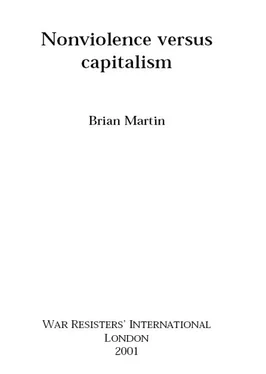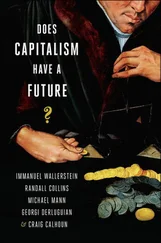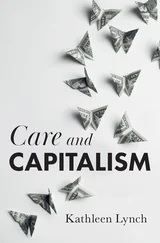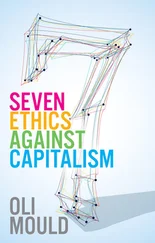Actually, there has been an enormous range of nonviolent action against aspects of capitalism — just not usually at the dramatic level of the above examples. [1] . Naomi Klein, No Logo (New York: Picador, 1999), gives an insightful survey of recent popular challenges to corporate power.
For example:
• workers’ direct action against employers, such as strikes, boycotts, work-to-rule and factory occupations, to obtain better pay and conditions or a greater say in decision making;
• workers’ control and cooperatives, providing alternatives to capitalist ownership and management;
• environmental movement campaigns against damaging industries, harmful products and new industrial developments;
• local campaigns against commercial developments (often linked to campaigns elsewhere);
• squatting in unoccupied buildings as a means of exposing and challenging private control over housing;
• global campaigns against agencies and arrangements extending the power of capital, such as campaigns against the World Bank and the Multilateral Agreement on Investment;
• direct action against genetically engineered crops.
As well as these initiatives that challenge aspects of capitalism, a close look at just about any aspect of capitalist society will reveal challenges using nonviolent action. Consider advertising, a crucial part of consumerism and the commodity-based culture. Responses have included rejection of advertising messages (as in “no junk mail” signs on mail boxes), campaigns against particular styles of advertising, and the creative defacing of billboards.
Nonviolent resistance to capitalism has occurred from the beginning of the industrial revolution through to the November-December 1999 protests in Seattle against the World Trade Organisation and subsequent protests in Washington DC, Prague, Melbourne and other cities against the International Monetary Fund, the World Bank and other global economic management forums. While there is ample nonviolent action within and against the capitalist system, this has not so often been conceived in terms of a nonviolence framework. Instead, the rhetoric and imagery of class struggle, including armed struggle, have had greater saliency in anticapitalist movements. Especially among Marxist organisers, there is neglect of or even antagonism to nonviolence.
The problem is compounded by a neglect of capitalism in writing and thinking on nonviolence. Gandhi’s constructive programme of village democracy and self-reliance was certainly noncapitalist, although capitalism as a system was not widely seen as one of his main targets in campaigning. However, nonviolence writers since Gandhi have largely neglected capitalism, and indeed this neglect can be traced to the heart of the consent theory of power used by Gene Sharp as the theoretical foundation of nonviolence theory. [2] . Gene Sharp, The Politics of Nonviolent Action [ (Boston: Porter Sargent, 1973), pp. 7-62. Sharp’s ideas are discussed in more detail in chapter 2.
Sharp’s model assumes a dichotomy between rulers and subjects: if subjects withdraw consent, the power of rulers dissolves. This model works best, as a foundation for practice, when rulers are obvious, as in a military dictatorship.
From the point of the view of the ruler-subject model, capitalism is a complex system. There used to be just a few owners at the top (and there still are a few such as Bill Gates and Rupert Murdoch), but increasingly ownership is dispersed among shareholders and managerial power dispersed within corporate bureaucracies. “Withdrawing consent” sounds easy enough in principle but what does it mean in practice: boycotting all corporations or refusing the boss’s orders? Most people participate in the market system in various ways that are not easily captured by the ruler-subject picture.
Capitalism is, in many ways, a more robust type of system than a dictatorial regime. Market relations draw people in, making them a part of the system, whereas a dictatorship has a more difficult time providing jobs and benefits to a large segment of the population. Injustice is experienced under both capitalism and a dictatorship, but with a dictatorship the source of injustice is easier to pinpoint. For nonviolence theory and practice, dictatorship is an “easy case”: people know what needs to be challenged, and the primary questions are about how to mobilise support and maintain campaigning momentum in the face of repression. Something more sophisticated is needed to transform capitalism.
Many of the most powerful instances of nonviolent action have been largely spontaneous, with little planning or training. This is often the case in resistance to military coups, such as the 1920 Kapp Putsch in Germany, the 1961 Algerian Generals’ Revolt and the 1991 coup in the Soviet Union. In each case the nonviolent resistance was improvised on the spot, partly because there was little or no warning that a coup would occur. Even in some of the longer campaigns, the level of planning and training has been low, such as the intifada in Palestine, which burst on the scene as a surprise to both Israelis and the Palestinian leadership and whose course over the years was more an organic development than a carefully calculated trajectory.
Spontaneous nonviolent action has a better chance of being successful when people have an intuitive grasp of what needs to be changed. In the case of a military coup, the coup must be defeated and the status quo (or better) restored. The intifada was a change of tactics — it was mass unarmed action rather than terrorism, which had been used unsuccessfully by the Palestinian Liberation Organisation — for a widely understood goal, namely ending the Israeli occupation. But if the goal is not so obvious to participants, then spontaneous nonviolent action — or violence, for that matter — is far less likely to be effective.
It was Gandhi who pioneered planning for nonviolent action. He saw overt action as part of a long-term strategy for social change, requiring great care in preparation, planning, discipline and training. His example has been taken to heart by a number of social movements, such as the US civil rights movement and antinuclear campaigners. Realising that an action may lack impact without sufficient preparation, if it is aimed at the wrong target or is ill-timed, campaigners have spent great effort in social analysis, community education and nonviolence training, in order to maximise effectiveness.
With planned nonviolent action, there is a much greater capacity to deal with complex systems of oppression, by working out targets that deal with the source of problems as well as tapping into popular concerns. A strike for higher pay can be valuable to exploited workers but does not challenge the relationship between employers and workers, whereas a work-in to demand a greater say in what is produced aims at a more fundamental change in the relationship.
It is worth noting that the strategies of Leninism and socialist electoralism are calculated, indirect and not “spontaneous.” Workers are expected to support political parties claiming to operate on their behalf rather than acting directly against those they see as their exploiters, such as their immediate bosses. Many workers have been sufficiently convinced that they channel their efforts away from “obvious” targets such as prominent capitalists, instead aiming at party building or election campaigning. Anticapitalist activists pursuing a strategy based on nonviolence can learn from this experience: workers and others are quite capable of understanding a long-term strategy for change that initially might not seem as intuitive as tackling obvious targets. The challenge is to develop a suitable strategy that engages large numbers of people.
Читать дальше

![Brian Jacques - Martin the Warrior [Redwall 6]](/books/128385/brian-jacques-martin-the-warrior-redwall-6-thumb.webp)










